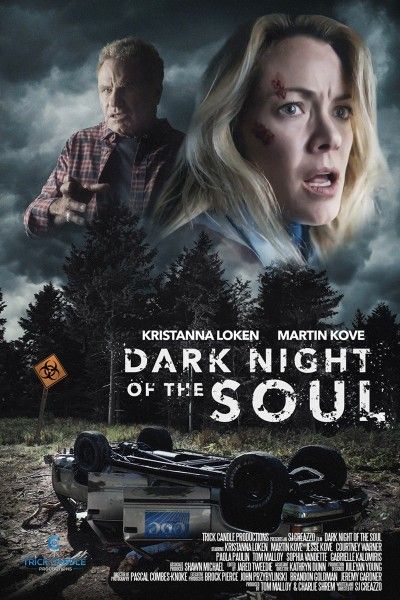
Rating: C
Dir: S.J. Creazzo
Star: Kristanna Loken, Martin Kove, Jesse Kove, Gabrielle Kalomiris
This takes place with the world in a grip of a pandemic, spawned by a prehistoric disease that has killed one-third of the population already. One of the few with a natural immunity is Alex (Loken), a researcher at the CDC. However, she is involved in a car accident on a remote highway, which leaves her trapped inside her car. As she drifts in an out of consciousness, and struggles to free herself, she has visions of conversations with her dead father (M. Kove), sister and daughter, providing cryptic insights into her personality – and, perhaps, towards a cure. Oh, and she is also visited by a little dog called God, because why not?
It’s interesting how quickly films about pandemics went from cutting-edge, to feeling closer to “2021 called – they want their premise back.” To be fair, it’s more a jumping-off point here, rather than the whole purpose. Indeed, wouldn’t take much to tweak the script and remove it, although you would still be left asking the audience the question: how long can you watch someone stuck in a car? The answer to that, for me, is “Longer than I expected, yet not long enough to fill the running time”. Again, outside of the first ten minutes, we don’t spend very long in the vehicle, with Alex’s dramatic hallucinations the bulk of the scenes. These are kinda interesting, but given this is sold as a thriller… it’s really not. Psychological drama is closer.
 Loken has to do a lot of the work here, being on screen in almost every scene, except for the nearby couple who are trying to decide if their sensors tripped by the car crash are just a rogue bear. This is as close to tension as the film provides, Creazzo being more interested in getting into Alex’s head-space. There’s no particular rhyme or reason in terms of structure there, and as a result, I felt it was all rather too loose to work effectively. However, I was impressed by the performances of both Loken and Kove Sr. [The other Kove, playing one of the couple mentioned above, is his son] and the photography, by Pascal Combes-Knoke, does the upstate New York scenery justice.
Loken has to do a lot of the work here, being on screen in almost every scene, except for the nearby couple who are trying to decide if their sensors tripped by the car crash are just a rogue bear. This is as close to tension as the film provides, Creazzo being more interested in getting into Alex’s head-space. There’s no particular rhyme or reason in terms of structure there, and as a result, I felt it was all rather too loose to work effectively. However, I was impressed by the performances of both Loken and Kove Sr. [The other Kove, playing one of the couple mentioned above, is his son] and the photography, by Pascal Combes-Knoke, does the upstate New York scenery justice.
In the end though, there are only two ways this can end. Either Alex survives, or she does not, and my level of emotional investment in the outcome was never particularly high. Despite a lot of effort clearly going into crafting a backstory for her, there wasn’t enough to make me truly care about Alex. The lack of other notable narrative impetus leaves the viewer somewhat stranded, if they can’t buy into the psychological underpinning. I do appreciate the way this does avoid the typical pandemic cliches. It probably just needs to find something better with which they can be replaced, since I found the results here too thin to sustain my attention.
The film is available on VOD and cable platforms today.
